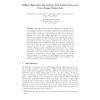Free Online Productivity Tools
i2Speak
i2Symbol
i2OCR
iTex2Img
iWeb2Print
iWeb2Shot
i2Type
iPdf2Split
iPdf2Merge
i2Bopomofo
i2Arabic
i2Style
i2Image
i2PDF
iLatex2Rtf
Sci2ools
ECCV
2002
Springer
2002
Springer
Diffuse-Specular Separation and Depth Recovery from Image Sequences
Specular reflections present difficulties for many areas of computer vision such as stereo and segmentation. To separate specular and diffuse reflection components, previous approaches generally require accurate segmentation, regionally uniform reflectance or structured lighting. To overcome these limiting assumptions, we propose a method based on color analysis and multibaseline stereo that simultaneously estimates the separation and the true depth of specular reflections. First, pixels with a specular component are detected by a novel form of color histogram differencing that utilizes the epipolar constraint. This process uses relevant data from all the stereo images for robustness, and addresses the problem of color occlusions. Based on the Lambertian model of diffuse reflectance, stereo correspondence is then employed to compute for specular pixels their corresponding diffuse components in other views. The results of color-based detection aid the stereo correspondence, which determ...
Computer Vision | ECCV 2002 | Multibaseline Stereo | Specular Component | Specular Pixels | Specular Reflections | Stereo Correspondence |
| Added | 16 Oct 2009 |
| Updated | 16 Oct 2009 |
| Type | Conference |
| Year | 2002 |
| Where | ECCV |
| Authors | Stephen Lin, Yuanzhen Li, Sing Bing Kang, Xin Tong, Heung-Yeung Shum |
Comments (0)

